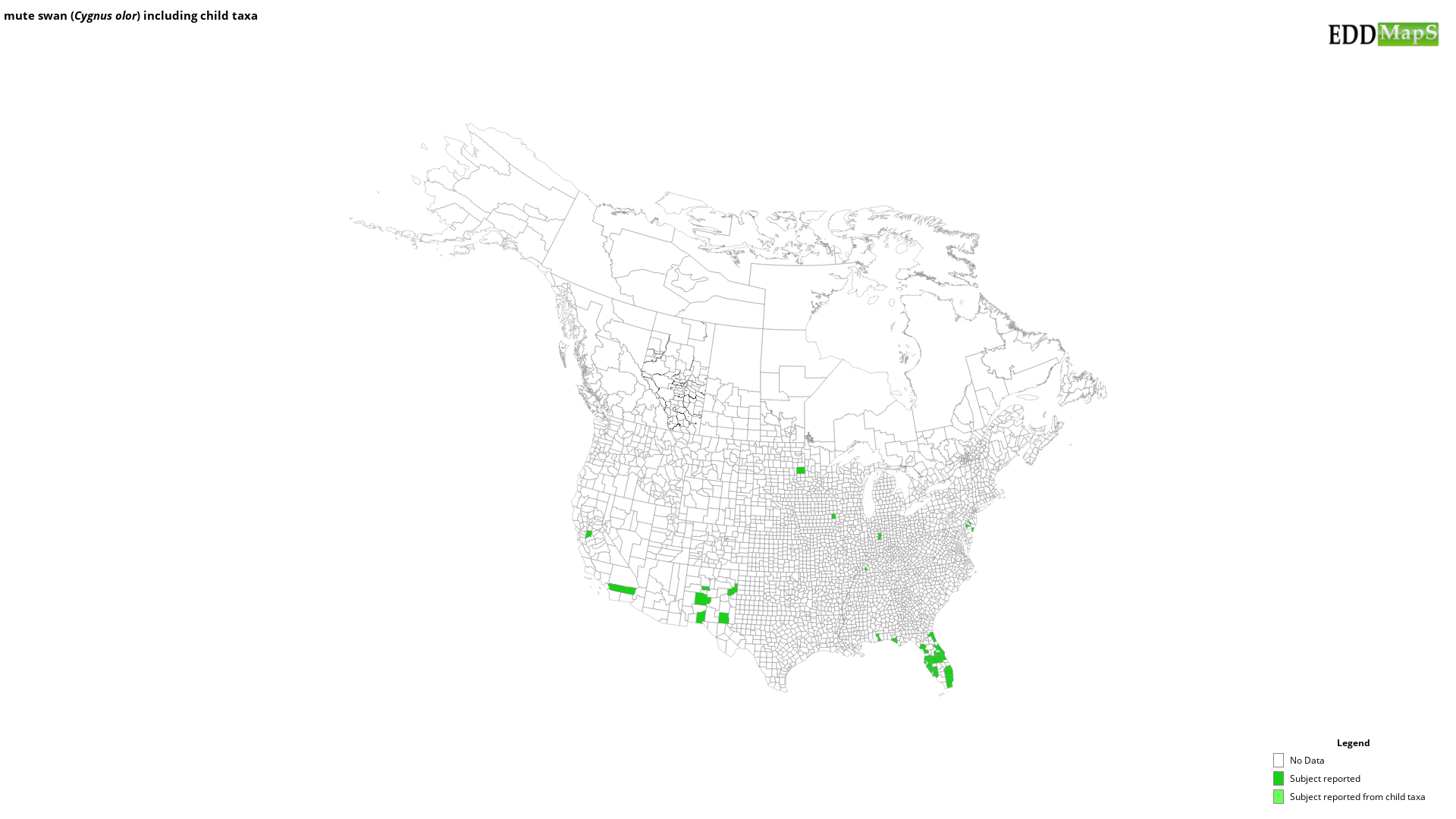mute swan
(Cygnus olor)
This species is Introduced in the United States
Origin
Cygnus olor is native to Europe and northcentral Asia. Mute swan were introduced to the United States for esthetics purposes.
Life Cycle
This is a large waterfowl species with a wingspan of 82-94 in. (208-238 cm) and 50-60 in. (127-152 cm) in length. Mute swans have completely white plumage with long necks, orange bills with a black knob at the base, and black legs, feet, and face. C. olor primarily eat vegetation with occasional small invertebrates and vertebrates. Male mute swans start building nests for females. Females lay 2-5 eggs and will incubate for 34-41 days. Young are reliant on adults after hatching.
Distribution
C. olor populations are established in ponds, lakes, and estuaries across the United States with higher densities in the eastern states.
Control Efforts
C. olor are aggressive birds that displace native species and destroy aquatic habitat by overgrazing. Control measures differ by state, please review your laws and regulations.
http://www.columbia.edu/itc/cerc/danoff-burg/invasion_bio/inv_spp_summ/Cygnus_olor.html
https://www.fws.gov/fisheries/ANS/erss/uncertainrisk/ERSS-Cygnus-olor-FINAL.pdf
https://nhpbs.org/wild/muteswan.asp
https://www.allaboutbirds.org/guide/Mute_Swan/lifehistory
Cygnus olor is native to Europe and northcentral Asia. Mute swan were introduced to the United States for esthetics purposes.
Life Cycle
This is a large waterfowl species with a wingspan of 82-94 in. (208-238 cm) and 50-60 in. (127-152 cm) in length. Mute swans have completely white plumage with long necks, orange bills with a black knob at the base, and black legs, feet, and face. C. olor primarily eat vegetation with occasional small invertebrates and vertebrates. Male mute swans start building nests for females. Females lay 2-5 eggs and will incubate for 34-41 days. Young are reliant on adults after hatching.
Distribution
C. olor populations are established in ponds, lakes, and estuaries across the United States with higher densities in the eastern states.
Control Efforts
C. olor are aggressive birds that displace native species and destroy aquatic habitat by overgrazing. Control measures differ by state, please review your laws and regulations.
http://www.columbia.edu/itc/cerc/danoff-burg/invasion_bio/inv_spp_summ/Cygnus_olor.html
https://www.fws.gov/fisheries/ANS/erss/uncertainrisk/ERSS-Cygnus-olor-FINAL.pdf
https://nhpbs.org/wild/muteswan.asp
https://www.allaboutbirds.org/guide/Mute_Swan/lifehistory
Resources
- Wikipedia - Wikimedia Foundation, Inc
- Animal Diversity Web - University of Michigan Museum of Zoology
- Global Invasive Species Database - Invasive Species Specialist Group
Selected Images
Maps
EDDMapS Distribution - This map is incomplete and is based only on current site and county level reports made by experts, herbaria, and literature. For more information, visit www.eddmaps.org
State Lists - This map identifies those states that have this species on their invasive species list or law.
Invasive Listing Sources
- Florida Invasive Species Partnership
- Maryland Aquatic Nuisance Species Plan
- Maryland Invasive Species Council - Invasive Species of Concern in Maryland
- Mid-Atlantic Field Guide to Aquatic Invasive Species
- Minnesota DNR invasive species list
- New Jersey Invasive Species Strike Team 2017 Invasive Species List
- New York Regulated and Prohibited Invasive Species - Prohibited
- Nonnative Invasive Species in Southern Forest and Grassland Ecosystems
- Virginia Invasive Species Management Plan 2012
Taxonomic Rank
| Domain: Eukarya |
| Kingdom: Animalia |
| Phylum: Chordata |
| Class: Aves |
| Order: Anseriformes |
| Family: Anatidae |
| Genus: Cygnus |
| Cygnus olor |
References
Common Name Reference: Integrated Taxonomic Information System on-line database.
Scientific Name Reference: Integrated Taxonomic Information System on-line database.


